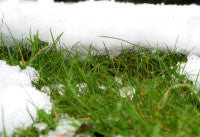Get active under the snow blanket
 Recent snowfall across areas of England and Scotland, combined with the sudden plunge in temperatures from icy northerly winds, has highlighted the risk of damaging Microdochium (Fusarium) Patch attack, warns Syngenta Technical Manager, Dr Simon Watson.
Recent snowfall across areas of England and Scotland, combined with the sudden plunge in temperatures from icy northerly winds, has highlighted the risk of damaging Microdochium (Fusarium) Patch attack, warns Syngenta Technical Manager, Dr Simon Watson.
He pointed out that, whilst last December last year was memorable for the incessant rainfall and unseasonably mild temperatures, in fact prolonged periods of snow cover have more common in recent seasons - resulting in extensive damage to unprotected turf beneath the snow blanket.
"When snowfall threatens, greenkeepers and turf managers must be ready to make a Medallion TL application and get protection in place early," he advised. "Treatment now means they can relax over the Christmas period, with the assurance their turf is protected."
 Dr Watson reported that in 2010 the temperatures quickly plummeted, with many areas under significant snow cover by early December. Although temperatures eased in the second week with a welcome thaw, mid-month saw a return to icy conditions and a further 10 to 14 days snow cover for many areas.
Dr Watson reported that in 2010 the temperatures quickly plummeted, with many areas under significant snow cover by early December. Although temperatures eased in the second week with a welcome thaw, mid-month saw a return to icy conditions and a further 10 to 14 days snow cover for many areas.
And whilst 2010 was extreme, it was not unprecedented; with similar periods of snow cover recorded in previous years, from late December 2009 into January 2010.
"The prospect of snow cover dramatically increases the risk of Microdochium (Fusarium) Patch. The snow acts as a thermal blanket at soil level and creates permanently moist leaf conditions, where the disease pathogen can thrive," said Dr Watson.
"Experiences in 2010 highlighted that when the snow thawed, turf without fungicide protection had been seriously hit. However, turf managers who had applied Medallion TL ahead of forecast snow cover and predicted high disease risk conditions, reported very good results with turf remaining disease free."
 In 2010, Hanbury Manor Golf Club Golf and Estate Manager, Stan Power, applied Medallion TL just prior to 10 days of snow cover. When the snow receded, visual results on the treated greens were very good and disease free, whilst Fusarium infection had started to occur on untreated surrounds.
In 2010, Hanbury Manor Golf Club Golf and Estate Manager, Stan Power, applied Medallion TL just prior to 10 days of snow cover. When the snow receded, visual results on the treated greens were very good and disease free, whilst Fusarium infection had started to occur on untreated surrounds.
Further heavy snowfall through December prevented further treatment, yet when the snow melted the trial greens still showed no signs of disease. On final inspection - six weeks after application - Mr Power reported all the greens treated with Medallion TL had come through the harsh winter period with no signs of disease. The untreated green, however, had seen a substantial amount of disease on the main playing surface and collars.
"We have been very happy with the results at Hanbury Manor, and would not hesitate to recommend Medallion TL to other courses as a contact fungicide," he added.
Forecasting 2012 disease risk
Early reports indicate that, after the cool and wet summer, there is a high incidence of Microdochium (Fusarium) inoculum present on the leaf and in the thatch in many turf surfaces, which is expected to increase as conditions turn more conducive, according to Dr Watson.
"Assessing this season's on-going risks, using the GreenCast five-day disease forecasts to proactively target application timing, can help to prevent disease affecting turf quality early in the winter, when there is little opportunity for recovery right through until the spring.
"Last year's incredibly wet and mild weather, with turf growth continuing right through to the New Year, was a timely reminder of the extremely variable conditions with which greenkeepers and turf mangers now have to contend." (Table 1).
Dr Watson advocated that using the free GreenCast weather and disease forecasting system, along with the historic records of weather and disease risk, can help time fungicide applications more effectively, to achieve the optimum results from every application.
"Where it is possible to foresee periods of disease risk there is potential to get the best protection from proactive applications of Medallion TL. Applying the contact+ active as close as possible to the infection period, targets turf pathogens on the leaf, thatch and soil to minimise damage."
Table 1. Comparing the weather conditions for December 2010 and 2011 highlights the huge differences - especially in temperature and number of frosts. For most parts it was also significantly wetter than normal and far duller.
|
Table 1. Comparing the weather conditions for December 2010 and 2011 highlights the huge differences - especially in temperature and number of frosts. For most parts it was also significantly wetter than normal and far duller. |
||||||||||||
|
Av Temp (°C) |
Sun (hours) |
Rain (mm) |
Days with air frost |
|||||||||
|
2010 |
2011 |
Diff. |
2010 |
2011 |
Diff. |
2010 |
2011 |
Diff. |
2010 |
2011 |
Diff. |
|
|
UK |
-0.9 |
4.8 |
+5.7 |
47 |
41 |
- 6 |
48 |
167 |
+119 |
23 |
7 |
-16 |
|
N. England |
-1.2 |
4.7 |
+5.9 |
59 |
46 |
-13 |
39 |
131 |
+92 |
23 |
7 |
-16 |
|
S. England |
0 |
6.1 |
+6.1 |
44 |
58 |
+14 |
33 |
88 |
+55 |
23 |
5 |
-18 |
|
Scotland |
-1.8 |
3.1 |
+4.9 |
42 |
27 |
-15 |
63 |
265 |
+202 |
24 |
12 |
-12 |
|
Wales |
-0.5 |
6.0 |
+6.5 |
50 |
29 |
-21 |
53 |
212 |
+159 |
23 |
4 |
-19 |
|
N Ireland |
-0.7 |
5.0 |
+4.5 |
62 |
26 |
-36 |
69 |
151 |
+82 |
22 |
5 |
-17 |
For further Press Information please contact:
Rod Burke Dr Simon Watson
Syngenta Turf & Landscape Syngenta Turf & Landscape
Tel: 01223 883468 Tel: 01223 883441
Email: rod.burke@syngenta.com Email: simon.watson@syngenta.com
For turf specific agronomy and product information go to www.greencast.co.uk
Syngenta turf products are distributed in the UK by Everris. www.everris.co.uk
Medallion TL can be purchased from the Pitchcare Shop
